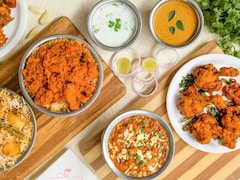When trying to lose weight, many people simply start eating less. However, eating less is a weight loss myth. Instead, it is advised to focus on eating healthy low-calorie foods, even if you eat them in good quantity. Being on a restrictive approach and depriving yourself is one of the most non-efficient paths one can take whether your goal is weight loss or simply a healthier way of eating, says Suhani Jain, Bloomwithin, Certified Nutritionist and Diet Consultant. "Instead, a more sensible and sustainable way could be - 'Volume Eating', wherein the focus is on choosing the foods that are high in volume but with a lower caloric value and hence lower calorie density. It is a smartly planned approach that allows you to indulge in larger portion sizes and creates a satisfying sense of fullness while also keeping track of the calorie intake."
Also Read: 5 Weight Loss-Friendly Recipes To Add A Dash Of Methi Magic To Your Breakfast
How 'Volume Eating' Helps In Weight Loss
Rupali Datta, Consultant Nutritionist, explains that eating foods that add bulk to our diet and not too many calories helps to reduce our total caloric intake. "The idea of voluminous diets is choosing low-calorie, high-bulk foods in larger quantities. So start the meal with a salad, choose fruits as snacks and add some high-fibre grains and plant proteins in adequate amounts to achieve weight loss goals while promoting health."
Nupuur Patil, a nutritionist adds, "By increasing the volume of food consumed without significantly raising calorie intake, individuals can curb hunger, reduce overall calorie consumption, and create a sustainable calorie deficit conducive to weight loss."
Photo Credit: iStock
5 Tips And Hacks For Adopting Volume Eating
After learning about the weight loss advantages of 'Volume Eating', are you wondering how to follow this diet? Here are some practical and easy tips that may be of help, as shared by Nutritionist Suhani Jain:
- Bulk up each meal with a wide variety of vegetables. Add spinach, gourds or zucchini into your morning omelette, in your cheelas, or khichdi. Stuff them into chapatis, make wraps, and salads, or mix sauteed or steamed veggies into pasta or veggie bowl dishes.
- Opt for smart snacking using high-volume low-calorie snacks like fresh fruits, air-popped popcorn, yoghurt, carrot and cucumber sticks with hung curd/ hummus dip.
- Always choose steaming, baking, roasting and grilling over deep frying or using an excess amount of fat for cooking.
- Start your meals with a broth-based soup, a wholesome salad or sauteed steamed veggies that will add volume and help you feel fuller before moving to more calorie-dense choices.
- Be cautious with calorie-loaded sauces, dressings and condiments and steer clear of hidden fats and sugars. Opt for better alternatives and use herbs, spices, lemon juice, vinegar, homemade chutney, hung curd-based dips, salsa or water-based pickled veggies.
Also Read: What's The Best Time To Eat Breakfast And Lose Weight? Let's Hear It From Experts
Disclaimer: This content including advice provides generic information only. It is in no way a substitute for qualified medical opinion. Always consult a specialist or your doctor for more information. NDTV does not claim responsibility for this information.
